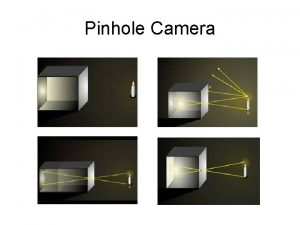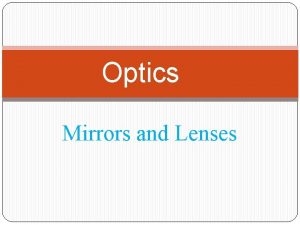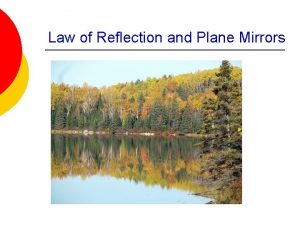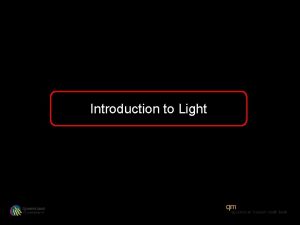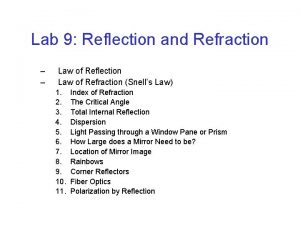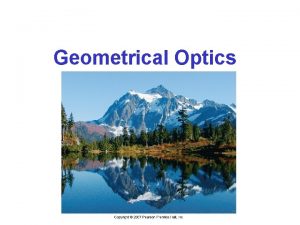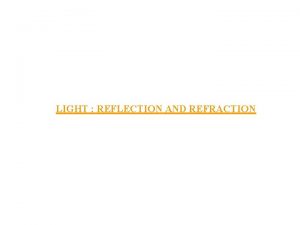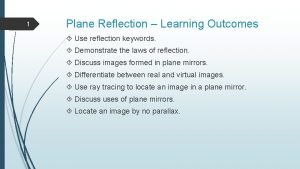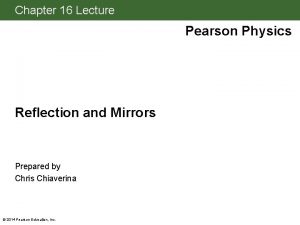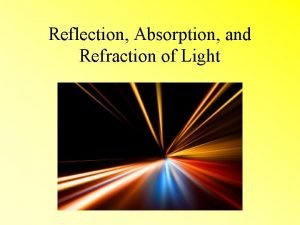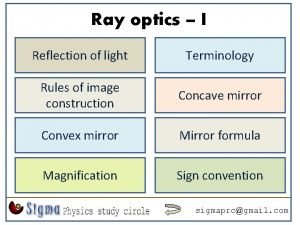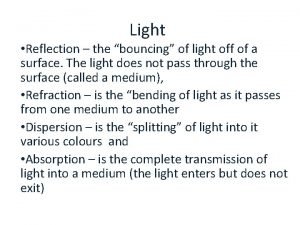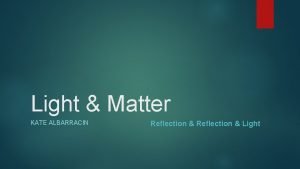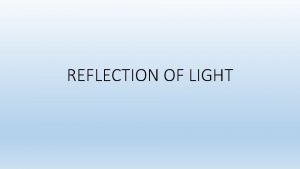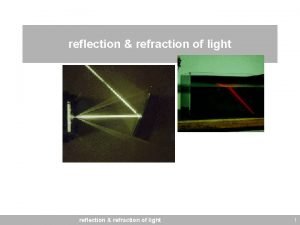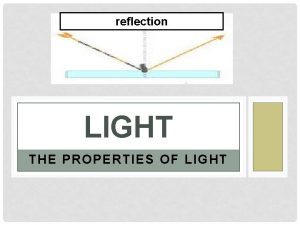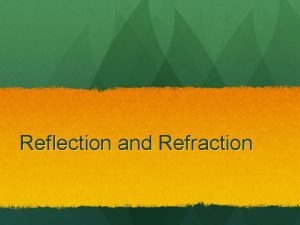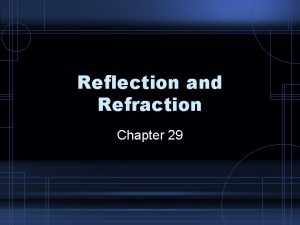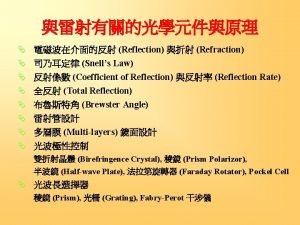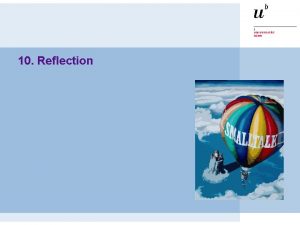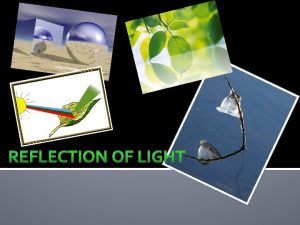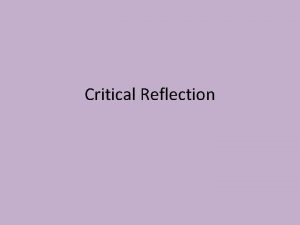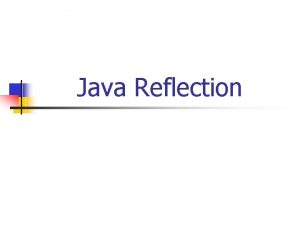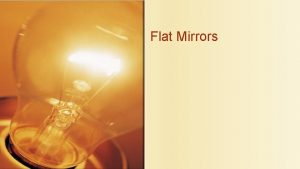Reflection of light A highly polished surface such
























- Slides: 24


Reflection of light

A highly polished surface, such as a mirror, reflects most of the light falling on it. We are already familiar with the laws of reflection of light. Let us recall these laws – � (i) The angle of incidence is equal to the angle of reflection, and � (ii) The incident ray, the normal to the mirror at the point of incidence and the reflected ray, all lie in the same plane. These laws of reflection are applicable to all types of reflecting surfaces including spherical surfaces

We are familiar with the formation of image by a plane mirror. � What are the properties of the image? � Image formed by a plane mirror is always virtual and erect. �The size of the image is equal to that of the object. �The image formed is as far behind the mirror as the object is in front of it. � Further, the image is laterally inverted. � How would the images be, when the reflecting surfaces are curved? �

Acvity � Take a large shining spoon. Try to view your face in its curved surface. � �Do you get the image? Is it smaller or larger? � �Move the spoon slowly away from your face. Observe the image. � How does it change? � � �Reverse the spoon and repeat the Activity. How does the image look like now? �Compare the characteristics of the image on the two surfaces.


The curved surface of a shining spoon could be considered as a curved mirror. The most commonly used type of curved mirror is the spherical mirror. The reflecting surface of such mirrors can be considered to form a part of the surface of a sphere. Such mirrors, whose reflecting surfaces are spherical, are called Spherical Mirrors

The reflecting surface of a spherical mirror may be curved inwards or outwards. A spherical mirror, whose reflecting surface is curved inwards, that is, faces towards the centre of the sphere, is called a concave mirror. � �A spherical mirror whose reflecting surface is curved outwards, is called a convex mirror.

Concave Mirror

Convex Mirror

�Now we going to understand the meaning of a few terms. These terms are commonly used in discussions about spherical mirrors. The centre of the reflecting surface of a spherical mirror is a point called the pole. �It lies on the surface of the mirror. �The pole is usually represented by the letter P. �


The reflecting surface of a spherical mirror forms a part of a sphere. This sphere has a centre. This point is called the centre of curvature of the spherical mirror. It is represented by the letter C. Please note that the centre of curvature is not a part of the mirror. It lies outside its reflecting surface. � The centre of curvature of a concave mirror lies in front of it. However, it lies behind the mirror in case of a convex mirror �

�The radius of the sphere of which the reflecting surface of a spherical mirror forms a part, is called the radius of curvature of the mirror. It is represented by the letter R. You may note that the distance PC is equal to the radius of curvature. � Imagine a straight line passing through the pole and the centre of curvature of a spherical mirror. This line is called the principal axis. Remember that principal axis is normal to the mirror at its pole �



Activity � CAUTION: Do not look at the Sun directly or even into a mirror reflecting sunlight. It may damage your eyes. � �Hold a concave mirror in your hand direct its reflecting surface towards the Sun. �Direct the light reflected by the mirror on to a sheet of paper held close to the mirror. �Move the sheet of paper back and forth gradually until you find on the paper sheet a bright, sharp spot of light. � �Hold the mirror and the paper in the same position for a few minutes. What do you observe? Why?


� The paper at first begins to burn producing smoke. Eventually it may even catch fire Why does it burn? � The light from the Sun is converged at a point, as a sharp, bright spot by the mirror. In fact, this spot of light is the image of the Sun on the sheet of paper. This point is the focus of the concave mirror. � The heat produced due to the concentration of sunlight ignites the paper. The distance of this image from the position of the mirror gives the approximate value of focal length of the mirror

� Let us try to understand this observation with the help of a ray diagram. � A number of rays parallel to the principal axis are falling on a concave mirror. Observe the reflected rays. They are all meeting/intersecting at a point on the principal axis of the mirror. This point is called the principal focus of the concave mirror. � � Similarly, the rays parallel to the principal axis are reflected by a convex mirror. The reflected rays appear to come from a point on the principal axis. This point is called the principal focus of the convex mirror. The principal focus is represented by the letter F. The distance between the pole and the principal focus of a spherical mirror is called the focal length. It is represented by the letter f


The diameter of the reflecting surface of spherical mirror is called its aperture. The � distance MN represents the aperture. �

� Is there a relationship between the radius of curvature R, and focal length f, of a spherical mirror? � For spherical mirrors of small apertures, the radius of curvature is found to be equal to twice the focal length �. We put this as � R = 2 f. � This implies that the principal focus of a spherical mirror lies midway between the pole and centre of curvature.

FOR MORE QUERIES: �YOU CAN LOG IN TO WEBSITE www. scienceeasylearning. wordpr ess. com �YOU CAN ALSO LIKE MY FB PAGE THAT IS: KKCHAUHAN
 Explain reflection
Explain reflection Polished shaft in the quiver of the almighty
Polished shaft in the quiver of the almighty His shoulders globed like a full sail strung
His shoulders globed like a full sail strung Chapter 22
Chapter 22 Light light light chapter 23
Light light light chapter 23 Light light light chapter 22
Light light light chapter 22 Plano convex lens
Plano convex lens Light strikes
Light strikes Point of incidence
Point of incidence Why can we represent light rays using a ruler
Why can we represent light rays using a ruler Laws of refraction
Laws of refraction What is mirror formula
What is mirror formula Reflection of light
Reflection of light Image formed by convex mirror
Image formed by convex mirror Use of reflection of light
Use of reflection of light Ye are the salt of the earth
Ye are the salt of the earth Reflection of light example
Reflection of light example Reflection light analogy
Reflection light analogy Characteristics of reflection of light
Characteristics of reflection of light Reflection refraction transmission and absorption of light
Reflection refraction transmission and absorption of light Terms used in reflection of light
Terms used in reflection of light Lateral area prism
Lateral area prism Spin coat
Spin coat Wet curved surface area
Wet curved surface area The bouncing of light
The bouncing of light
